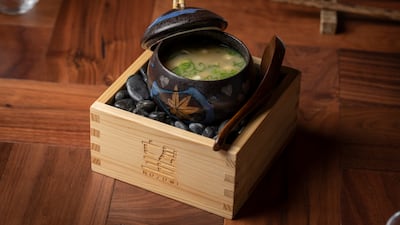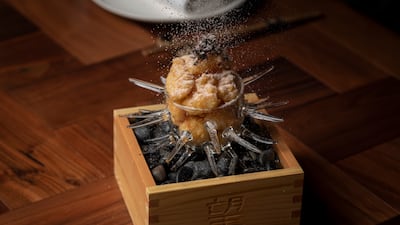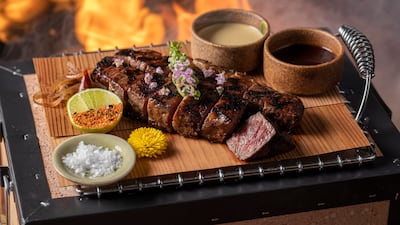Founded in 2004 by restaurateur Marios George, the first Nozomi in London was a huge hit with Saudi travellers.
Its Riyadh outpost quickly became known as one of the best fine-dining establishments in the kingdom. In March, Al Moajil Hospitality group took the Japanese restaurant to Matal, the new corniche development in Al Khobar – and this one's bigger and better than ever.
Where to expect and where to sit
Located on the second floor of the food complex in Matal, Nozomi is described as a “hidden gem” by chef Pawel Viktorek, culinary director of Al Moajil Hospitality.
Viktorek, who has been in the kingdom for three years and has had experience heading Zuma, says: “After all my years in the GCC, I like Saudi Arabia the most, especially Al Khobar. The people are friendly and the location is great with a beautiful shoreline. I find Al Khobar is a hidden gem, just like this restaurant.”
Indeed, everything seems to slow down once you walk into Nozomi, and you're greeted with a refreshing scent and smiling hostesses. Within, traditional Japanese architecture, replete with bamboo and wood, creates a secluded, intimate and luxurious space for diners, while a seat on the terrace comes with beautiful views of the Moon suspended over Khobar's corniche.
The menu
Nozomi is the first restaurant in Khobar to ship its produce – from the seafood and Grade 12+ Wagyu to the wasabi – directly from Japan, guaranteeing the “freshness and quality of your sushi platter”, Viktorek says.
My dining partner and I start with edamame followed by miso soup, one with Angus beef, the other with vegetables, served in colour-coordinated handcrafted ceramic bowls. The accompanying steamed buns are stuffed with Angus and tonkatsu sauce, and are branded with the Nozomi logo for an Instagrammable shot.
Next we try the crispy fried shrimp popcorn. This is served with a side of green chilli mayonnaise, which is a refreshing change from the typical sauce-drenched style. It's tempting to keep on snacking, but do save room for the authentic Japanese seafood platter, which is exquisite. It includes hamachi, akami and an unbelievably fresh and delicious gold-seared salmon dressed with avocado truffle cream and tobiko, and classic California maki.
While Wagyu beef sliders are a favourite starter in Saudi Arabia, we'd replace them with Nozomi's new entry: Wagyu sandos, scrumptiously tender meat sandwiched between soft brioche.
Stand-out dish
The Wagyu sando is the unexpected star of the show, and comes sprinkled with 24k gold confetti. The juicy meat and buttery bread are held together with Japanese honey mustard, all of which melts in the mouth and fills up the heart simultaneously.
The flavourful, tender black cod is another showstopper. It comes wrapped in bamboo branded with the Nozomi logo, and unfolds in front of your eyes.
A chat with the chef
Head chef Gohei Kishi says he always tries to bring out the most umami flavour in his dishes. “Umami-focused dishes can be about enhancing the flavour of a single ingredient, or touching upon five points: the main ingredient, freshness, aroma, texture and even the colour.”
Some dishes Kishi recommends include: for vegetarians, the mushroom takikomi rice, with shiitake, dashi kombu, soy miso butter and shiso powder; for meat-lovers, Grade 12+ Japanese Wagyu beef cooked on a charcoal robata grill; for seafood-seekers, a sushi-sashimi omakase platter; and, for dessert, the signature sharing platter filled with exotic fruit, fondant au chocolate, miso cheesecake and sorbets.
Those celebrating something special can glam up their table with chef Pawel's recommendation: the indulgent seared salmon truffle maki with 24k gold.
Price point and contact information
Small dishes range from the miso soup, priced at a modest 35 Saudi riyals ($9), to the Wagyu sliders, which will set you back SR210. The chef's nigiri and sashimi platters go from SR200-SR350, while maki rolls are priced in the SR78-SR135 range. Mains are divided between seafood (SR145-SR255) and robata meats (SR138-SR270), and desserts go from SR58 for three scoops of ice cream, to a tasting platter for SR380.
Reservations are recommended and can be made by calling +966 9200 12681 or from the website.
This review was conducted at the invitation of the restaurant
Cricket World Cup League 2 Fixtures
Saturday March 5, UAE v Oman, ICC Academy (all matches start at 9.30am)
Sunday March 6, Oman v Namibia, ICC Academy
Tuesday March 8, UAE v Namibia, ICC Academy
Wednesday March 9, UAE v Oman, ICC Academy
Friday March 11, Oman v Namibia, Sharjah Cricket Stadium
Saturday March 12, UAE v Namibia, Sharjah Cricket Stadium
UAE squad
Ahmed Raza (captain), Chirag Suri, Muhammad Waseem, CP Rizwan, Vriitya Aravind, Asif Khan, Basil Hameed, Rohan Mustafa, Kashif Daud, Zahoor Khan, Junaid Siddique, Karthik Meiyappan, Akif Raja, Rahul Bhatia
Five personal finance podcasts from The National
To help you get started, tune into these Pocketful of Dirham episodes
·
Balance is essential to happiness, health and wealth
·
What is a portfolio stress test?
·
What are NFTs and why are auction houses interested?
·
How gamers are getting rich by earning cryptocurrencies
·
Should you buy or rent a home in the UAE?
360Vuz PROFILE
Date started: January 2017
Founder: Khaled Zaatarah
Based: Dubai and Los Angeles
Sector: Technology
Size: 21 employees
Funding: $7 million
Investors: Shorooq Partners, KBW Ventures, Vision Ventures, Hala Ventures, 500Startups, Plug and Play, Magnus Olsson, Samih Toukan, Jonathan Labin
Dust and sand storms compared
Sand storm
- Particle size: Larger, heavier sand grains
- Visibility: Often dramatic with thick "walls" of sand
- Duration: Short-lived, typically localised
- Travel distance: Limited
- Source: Open desert areas with strong winds
Dust storm
- Particle size: Much finer, lightweight particles
- Visibility: Hazy skies but less intense
- Duration: Can linger for days
- Travel distance: Long-range, up to thousands of kilometres
- Source: Can be carried from distant regions
PREMIER LEAGUE FIXTURES
Tuesday (UAE kick-off times)
Leicester City v Brighton (9pm)
Tottenham Hotspur v West Ham United (11.15pm)
Wednesday
Manchester United v Sheffield United (9pm)
Newcastle United v Aston Villa (9pm)
Norwich City v Everton (9pm)
Wolves v Bournemouth (9pm)
Liverpool v Crystal Palace (11.15pm)
Thursday
Burnley v Watford (9pm)
Southampton v Arsenal (9pm)
Chelsea v Manchester City (11.15pm)
ELECTION%20RESULTS
%3Cp%3EMacron%E2%80%99s%20Ensemble%20group%20won%20245%20seats.%26nbsp%3B%3C%2Fp%3E%0A%3Cp%3EThe%20second-largest%20group%20in%20parliament%20is%20Nupes%2C%20a%20leftist%20coalition%20led%20by%20Jean-Luc%20Melenchon%2C%20which%20gets%20131%20lawmakers.%26nbsp%3B%3C%2Fp%3E%0A%3Cp%3EThe%20far-right%20National%20Rally%20fared%20much%20better%20than%20expected%20with%2089%20seats.%3C%2Fp%3E%0A%3Cp%3EThe%20centre-right%20Republicans%20and%20their%20allies%20took%2061.%3C%2Fp%3E%0A
Bib%20Gourmand%20restaurants
%3Cp%3EAl%20Khayma%0D%3Cbr%3EBait%20Maryam%0D%3Cbr%3EBrasserie%20Boulud%0D%3Cbr%3EFi'lia%0D%3Cbr%3Efolly%0D%3Cbr%3EGoldfish%0D%3Cbr%3EIbn%20AlBahr%0D%3Cbr%3EIndya%20by%20Vineet%0D%3Cbr%3EKinoya%0D%3Cbr%3ENinive%0D%3Cbr%3EOrfali%20Bros%0D%3Cbr%3EReif%20Japanese%20Kushiyaki%0D%3Cbr%3EShabestan%0D%3Cbr%3ETeible%3C%2Fp%3E%0A
COMPANY%20PROFILE
%3Cp%3E%3Cstrong%3ECompany%20name%3A%3C%2Fstrong%3E%20Revibe%20%0D%3Cbr%3E%3Cstrong%3EStarted%3A%3C%2Fstrong%3E%202022%0D%3Cbr%3E%3Cstrong%3EFounders%3A%3C%2Fstrong%3E%20Hamza%20Iraqui%20and%20Abdessamad%20Ben%20Zakour%20%0D%3Cbr%3E%3Cstrong%3EBased%3A%3C%2Fstrong%3E%20UAE%20%0D%3Cbr%3E%3Cstrong%3EIndustry%3A%3C%2Fstrong%3E%20Refurbished%20electronics%20%0D%3Cbr%3E%3Cstrong%3EFunds%20raised%20so%20far%3A%3C%2Fstrong%3E%20%2410m%20%0D%3Cbr%3E%3Cstrong%3EInvestors%3A%20%3C%2Fstrong%3EFlat6Labs%2C%20Resonance%20and%20various%20others%0D%3C%2Fp%3E%0A
Apple's%20Lockdown%20Mode%20at%20a%20glance
%3Cp%3EAt%20launch%2C%20Lockdown%20Mode%20will%20include%20the%20following%20protections%3A%3C%2Fp%3E%0A%3Cp%3E%3Cstrong%3EMessages%3A%3C%2Fstrong%3E%20Most%20attachment%20types%20other%20than%20images%20are%20blocked.%20Some%20features%2C%20like%20link%20previews%2C%20are%20disabled%3C%2Fp%3E%0A%3Cp%3E%3Cstrong%3EWeb%20browsing%3A%3C%2Fstrong%3E%20Certain%20complex%20web%20technologies%2C%20like%20just-in-time%20JavaScript%20compilation%2C%20are%20disabled%20unless%20the%20user%20excludes%20a%20trusted%20site%20from%20Lockdown%20Mode%3C%2Fp%3E%0A%3Cp%3E%3Cstrong%3EApple%20services%3A%20%3C%2Fstrong%3EIncoming%20invitations%20and%20service%20requests%2C%20including%20FaceTime%20calls%2C%20are%20blocked%20if%20the%20user%20has%20not%20previously%20sent%20the%20initiator%20a%20call%20or%20request%3C%2Fp%3E%0A%3Cp%3E%3Cstrong%3EConnectivity%3A%3C%2Fstrong%3E%20Wired%20connections%20with%20a%20computer%20or%20accessory%20are%20blocked%20when%20an%20iPhone%20is%20locked%3C%2Fp%3E%0A%3Cp%3E%3Cstrong%3EConfigurations%3A%3C%2Fstrong%3E%20Configuration%20profiles%20cannot%20be%20installed%2C%20and%20the%20device%20cannot%20enroll%20into%20mobile%20device%20management%20while%20Lockdown%20Mode%20is%20on%3C%2Fp%3E%0A
Company profile
Name: Steppi
Founders: Joe Franklin and Milos Savic
Launched: February 2020
Size: 10,000 users by the end of July and a goal of 200,000 users by the end of the year
Employees: Five
Based: Jumeirah Lakes Towers, Dubai
Financing stage: Two seed rounds – the first sourced from angel investors and the founders' personal savings
Second round raised Dh720,000 from silent investors in June this year
Crime%20Wave
%3Cp%3EHeavyweight%20boxer%20Fury%20revealed%20on%20Sunday%20his%20cousin%20had%20been%20%E2%80%9Cstabbed%20in%20the%20neck%E2%80%9D%20and%20called%20on%20the%20courts%20to%20address%20the%20wave%20of%20more%20sentencing%20of%20offenders.%26nbsp%3B%3C%2Fp%3E%0A%3Cp%3ERico%20Burton%2C%2031%2C%20was%20found%20with%20stab%20wounds%20at%20around%203am%20on%20Sunday%20in%20Goose%20Green%2C%20Altrincham%20and%20subsequently%20died%20of%20his%20injuries.%3C%2Fp%3E%0A%3Cp%3E%26nbsp%3B%E2%80%9CMy%20cousin%20was%20murdered%20last%20night%2C%20stabbed%20in%20the%20neck%20this%20is%20becoming%20ridiculous%20%E2%80%A6%20idiots%20carry%20knives.%20This%20needs%20to%20stop%2C%E2%80%9D%0D%20Fury%20said.%20%E2%80%9CAsap%2C%20UK%20government%20needs%20to%20bring%20higher%20sentencing%20for%20knife%20crime%2C%20it%E2%80%99s%20a%20pandemic%20%26amp%3B%20you%20don%E2%80%99t%20know%20how%20bad%20it%20is%20until%20%5Bit%E2%80%99s%5D%201%20of%20your%20own!%3C%2Fp%3E%0A
UAE currency: the story behind the money in your pockets
Key facilities
- Olympic-size swimming pool with a split bulkhead for multi-use configurations, including water polo and 50m/25m training lanes
- Premier League-standard football pitch
- 400m Olympic running track
- NBA-spec basketball court with auditorium
- 600-seat auditorium
- Spaces for historical and cultural exploration
- An elevated football field that doubles as a helipad
- Specialist robotics and science laboratories
- AR and VR-enabled learning centres
- Disruption Lab and Research Centre for developing entrepreneurial skills
MATCH INFO
Fulham 0
Aston Villa 3 (Grealish 4', Hourihane 15', Mings 48')
Man of the match: Jack Grealish (Aston Villa)
Tips%20for%20holiday%20homeowners
%3Cp%3EThere%20are%20several%20factors%20for%20landlords%20to%20consider%20when%20preparing%20to%20establish%20a%20holiday%20home%3A%3C%2Fp%3E%0A%3Cul%3E%0A%3Cli%3E%3Cstrong%3ERevenue%20potential%20of%20the%20unit%3A%3C%2Fstrong%3E%20location%2C%20view%20and%20size%3C%2Fli%3E%0A%3Cli%3E%3Cstrong%3EDesign%3A%20furnished%20or%20unfurnished.%3C%2Fstrong%3E%20Is%20the%20design%20up%20to%20standard%2C%20while%20being%20catchy%20at%20the%20same%20time%3F%3C%2Fli%3E%0A%3Cli%3E%3Cstrong%3EBusiness%20model%3A%3C%2Fstrong%3E%20will%20it%20be%20managed%20by%20a%20professional%20operator%20or%20directly%20by%20the%20owner%2C%20how%20often%20does%20the%20owner%20wants%20to%20use%20it%20for%20personal%20reasons%3F%3C%2Fli%3E%0A%3Cli%3E%3Cstrong%3EQuality%20of%20the%20operator%3A%3C%2Fstrong%3E%20guest%20reviews%2C%20customer%20experience%20management%2C%20application%20of%20technology%2C%20average%20utilisation%2C%20scope%20of%20services%20rendered%3C%2Fli%3E%0A%3C%2Ful%3E%0A%3Cp%3E%3Cem%3ESource%3A%20Adam%20Nowak%2C%20managing%20director%20of%20Ultimate%20Stay%20Vacation%20Homes%20Rental%3C%2Fem%3E%3C%2Fp%3E%0A
UK-EU trade at a glance
EU fishing vessels guaranteed access to UK waters for 12 years
Co-operation on security initiatives and procurement of defence products
Youth experience scheme to work, study or volunteer in UK and EU countries
Smoother border management with use of e-gates
Cutting red tape on import and export of food
Profile Idealz
Company: Idealz
Founded: January 2018
Based: Dubai
Sector: E-commerce
Size: (employees): 22
Investors: Co-founders and Venture Partners (9 per cent)
RESULTS
5pm Maiden (PA) Dh70,000 (Dirt) 1,400m
Winner AF Nashrah, Tadhg O’Shea (jockey), Ernst Oertel (trainer)
5.30pm Maiden (PA) Dh70,000 (D) 1,400m
Winner Mutaqadim, Riccardo Iacopini, Ibrahim Al Hadhrami.
6pm Maiden (PA) Dh70,000 (D) 1,600m
Winner Hameem, Jose Santiago, Abdallah Al Hammadi.
6.30pm Maiden (PA) Dh70,000 (D) 1,600m
Winner AF Almomayaz, Sandro Paiva, Ali Rashid Al Raihe.
7pm Handicap (PA) Dh70,000 (D) 1,800m
Winner Dalil Al Carrere, Fernando Jara, Mohamed Daggash.
7.30pm Handicap (TB) Dh70,000 (D) 1,000m
Winner Lahmoom, Royston Ffrench, Salem bin Ghadayer.
8pm Handicap (PA) Dh70,000 (D) 1,000m
Winner Jayide Al Boraq, Bernardo Pinheiro, Khalifa Al Neyadi.
What are the GCSE grade equivalents?
- Grade 9 = above an A*
- Grade 8 = between grades A* and A
- Grade 7 = grade A
- Grade 6 = just above a grade B
- Grade 5 = between grades B and C
- Grade 4 = grade C
- Grade 3 = between grades D and E
- Grade 2 = between grades E and F
- Grade 1 = between grades F and G
SAUDI RESULTS
Team Team Pederson (-40), Team Kyriacou (-39), Team De Roey (-39), Team Mehmet (-37), Team Pace (-36), Team Dimmock (-33)
Individual E. Pederson (-14), S. Kyriacou (-12), A van Dam (-12), L. Galmes (-12), C. Hull (-9), E. Givens (-8),
G. Hall (-8), Ursula Wikstrom (-7), Johanna Gustavsson (-7)
Common OCD symptoms and how they manifest
Checking: the obsession or thoughts focus on some harm coming from things not being as they should, which usually centre around the theme of safety. For example, the obsession is “the building will burn down”, therefore the compulsion is checking that the oven is switched off.
Contamination: the obsession is focused on the presence of germs, dirt or harmful bacteria and how this will impact the person and/or their loved ones. For example, the obsession is “the floor is dirty; me and my family will get sick and die”, the compulsion is repetitive cleaning.
Orderliness: the obsession is a fear of sitting with uncomfortable feelings, or to prevent harm coming to oneself or others. Objectively there appears to be no logical link between the obsession and compulsion. For example,” I won’t feel right if the jars aren’t lined up” or “harm will come to my family if I don’t line up all the jars”, so the compulsion is therefore lining up the jars.
Intrusive thoughts: the intrusive thought is usually highly distressing and repetitive. Common examples may include thoughts of perpetrating violence towards others, harming others, or questions over one’s character or deeds, usually in conflict with the person’s true values. An example would be: “I think I might hurt my family”, which in turn leads to the compulsion of avoiding social gatherings.
Hoarding: the intrusive thought is the overvaluing of objects or possessions, while the compulsion is stashing or hoarding these items and refusing to let them go. For example, “this newspaper may come in useful one day”, therefore, the compulsion is hoarding newspapers instead of discarding them the next day.
Source: Dr Robert Chandler, clinical psychologist at Lighthouse Arabia
THE CARD
2pm: Maiden Dh 60,000 (Dirt) 1,400m
2.30pm: Handicap Dh 76,000 (D) 1,400m
3pm: Handicap Dh 64,000 (D) 1,200m
3.30pm: Shadwell Farm Conditions Dh 100,000 (D) 1,000m
4pm: Maiden Dh 60,000 (D) 1,000m
4.30pm: Handicap 64,000 (D) 1,950m

















